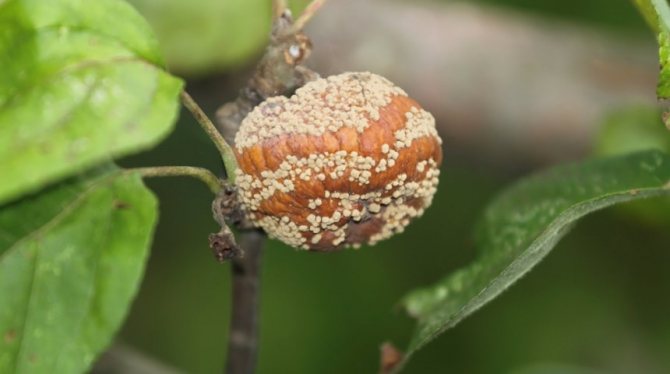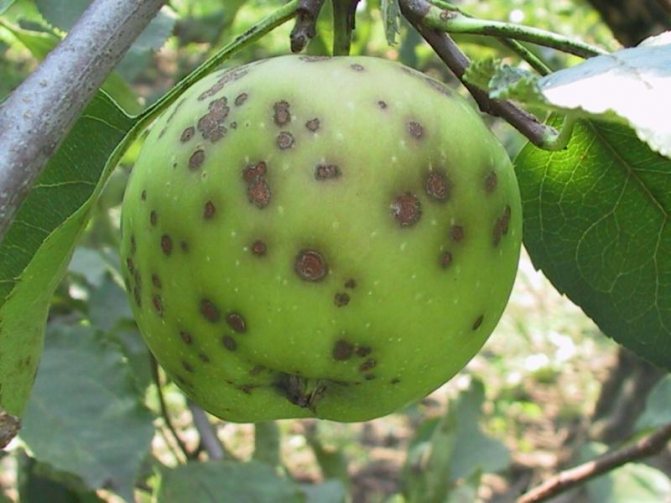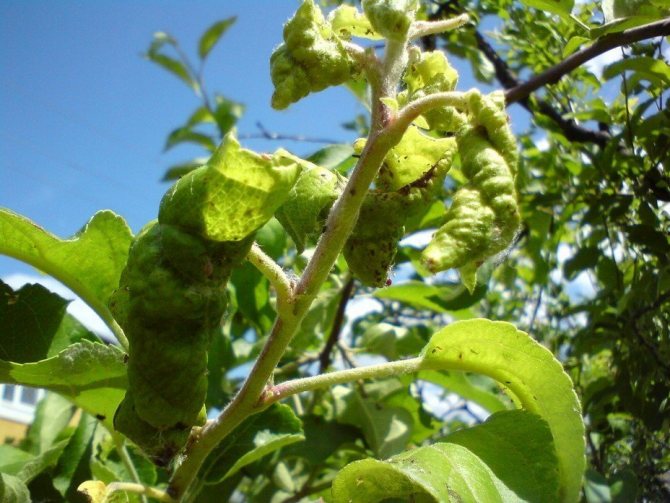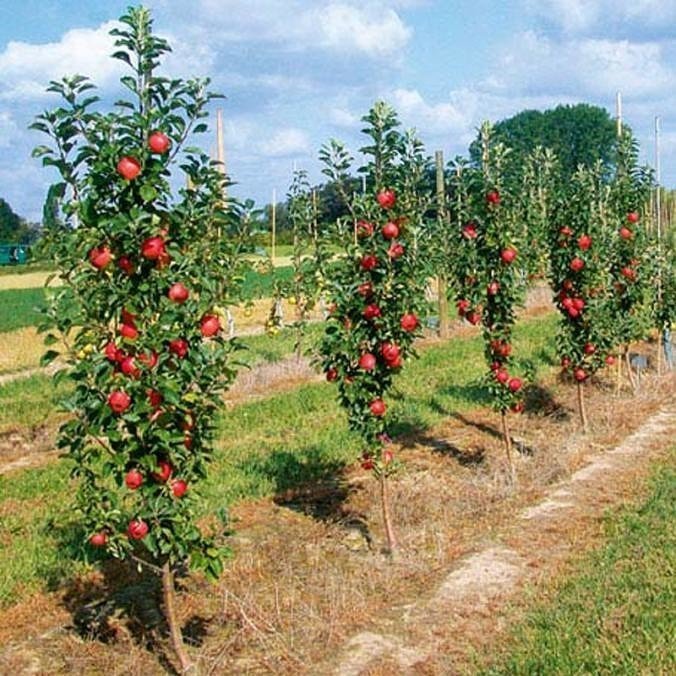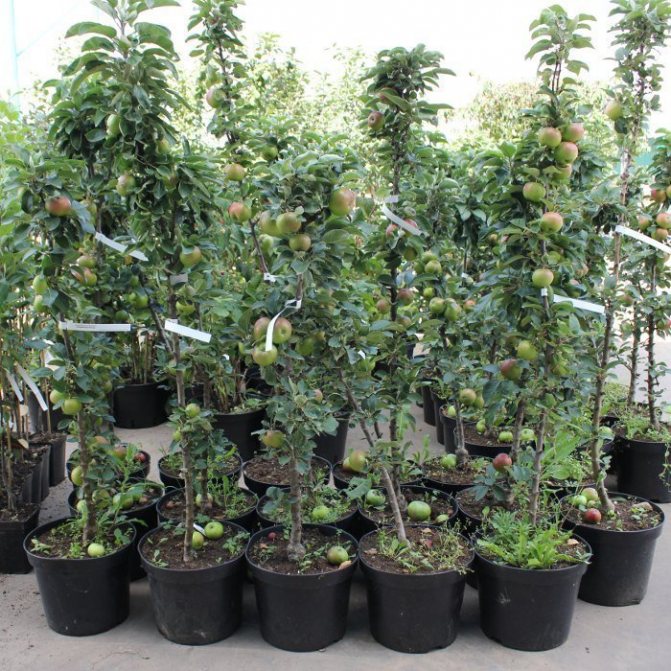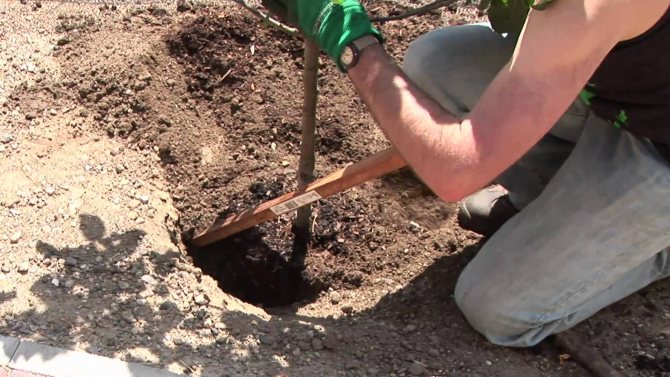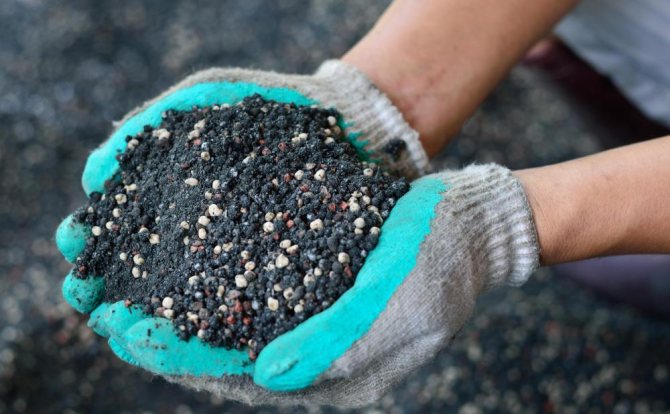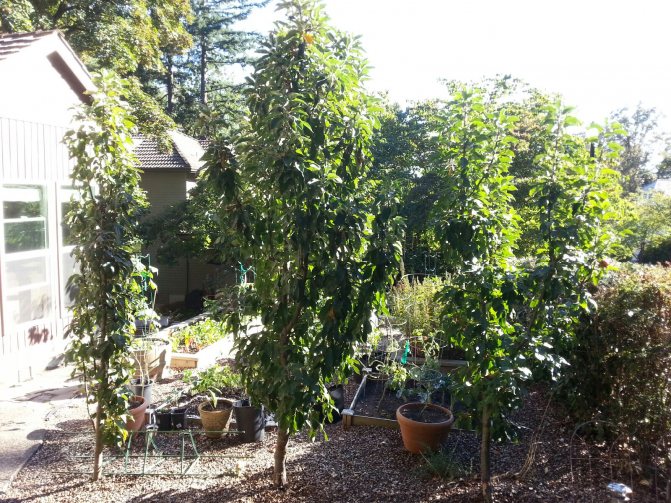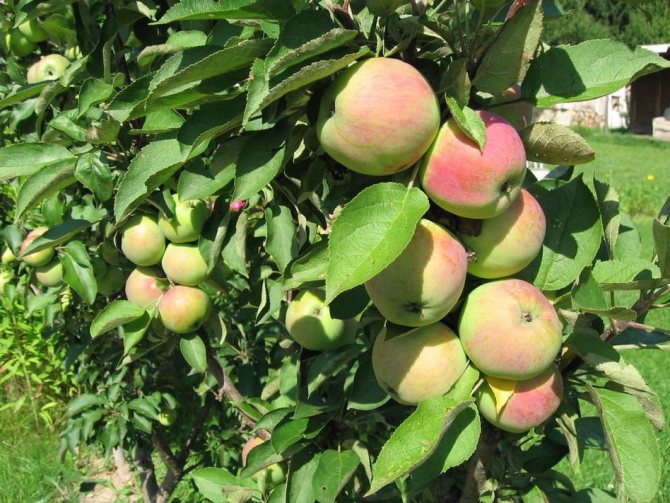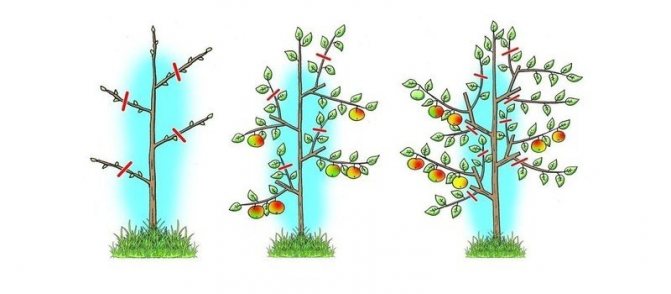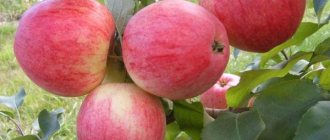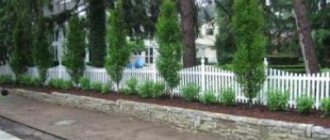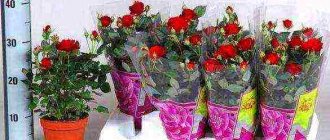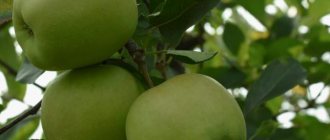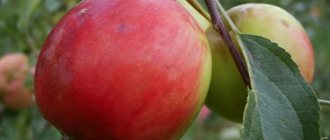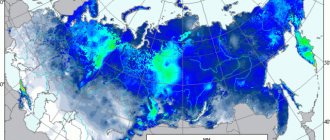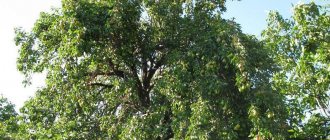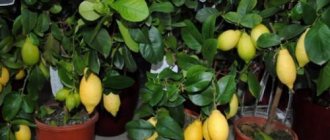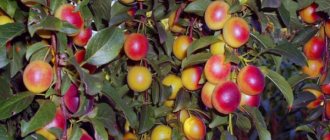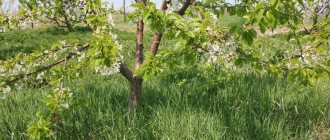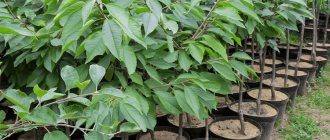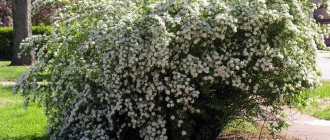Description of the variety
Belongs to the category semi-dwarf trees reaching a height of about 2 m.
Fruit begin to develop 30 cm from the ground and appear early due to the early type of fruiting culture.
Trunk, resembling the shape of a column, densely strewn with reproductive shoots in the form of ringlets and spears.
By characteristics wood the apple tree is firm enough that it does not allow it to bend even under a large harvest.
Have fruit formations life expectancy varies up to 15 years with adequate plant care.
Below for you are photos of the columnar apple trees President.
Important! The root system of the planting material is very dense, which significantly affects the good survival rate with any transplant.
Preparing for winter
Up to three years old, columnar apple trees need high-quality and timely insulation:
- first, the fallen leaves are removed in the garden, a shallow digging is carried out at a distance of 1 m from the trunk circle, so as not to damage the root system;
- at the bottom, the trunk is whitewashed with slaked lime with the addition of fungicides;
- then they spud with peat at a height of 15 cm, they also add this component to the root area to protect the roots from freezing;
- wrapped on top with a film, a chain-link - in such a shelter, the risk of freezing is minimal and there is good protection from rodents;
- the crown is wrapped in burlap, covered with spruce branches.
It is possible to remove the insulation material in the spring, when the threat of return frosts has passed and the snow has melted.
Characteristics
The difference between this type of apple trees and ordinary ones in the presence of one single barrel, overgrown with short fruit formations.
Size of an adult tree
See what the President's columnar apple tree looks like in the photo:
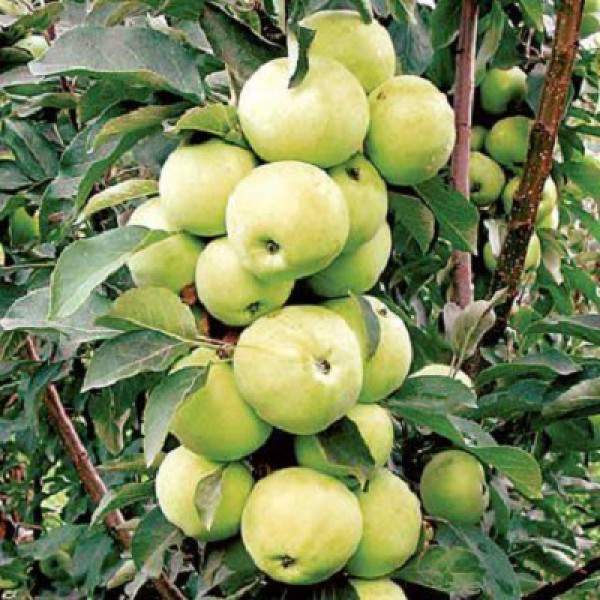
Apple variety President.
The shortened internodes allow the leaves to be located close to each other, forming a dense green column, rarely exceeding the height two meters.
And since the lateral shoots come out of the trunk at an acute angle, the crown is very compact, extending only 15-20 cm from the trunk.
Annual growth
According to the relative growth (or, as they say, the strength of growth), the tree belongs to natural semi-dwarfs.
In the period of full fruiting, the annual growth, depending on the conditions and care, averages about 7-8 cm.
The frequency of fruiting
The crop is regular, although sometimes it fluctuates from year to year.
Usually it is about 8 kg of apples.
With good soil conditions and adequate maintenance yield rises to 10-12 kg.
If the agricultural background is constantly maintained, then the yield can reach up to 16 kg per tree.
Important! Even with bad weather and no pollinators, the variety is different tying fruits during flowering.
Winter hardiness
Cold resistance is comparable to Antonovka and Melba. Is considered winter hardy... Still, young trees need to be prepared for the winter cold.
For this, shelters are prepared from ephedra or straw, having previously protected the trunk from rodents... In a more temperate climate, in the first two years, it is recommended to wrap the trunk in three layers of covering, dense material.
Disease resistance
In terms of resistance to diseases and pests, it is at the level of the best varieties. But like all garden crops requires preventive protection measures. To do this, timely conduct spraying preparations for various kinds of pests.
Tasting assessment
The apples are large enough for such a small tree. On average, 200 g. In shape, rounded-flattened, resembling the shape of a turnip.
The fruits are yellow-white in color and have a very attractive pink blush.
Have a thin, shinybut a substantially dense skin.
Fine-grained, creamy flesh surprises dessert taste, pronounced aroma and tasting score 4, 8 - 5 points.
Advantages and disadvantages of the variety
Columnar apple trees have a number of merits... This also applies to the President variety.
Advantages:
- Lack of lateral branching;
- Early entry into fruiting;
- Decorativeness and compactness of the tree;
- Convenience of harvesting;
- Good survival rate during transplantation;
- High yield for this species and excellent taste of apples;
- Average level of winter hardiness;
- Resistant to diseases and pests.
Disadvantages:
- Demanding care;
- Low keeping quality;
- Small tree height;
- The high price of seedlings.
Features of planting and care
Seat requirements:
- Illumination,
- Lack of groundwater at a depth of less than two meters,
- A windless place is the most preferable conditions for this. hybrid.
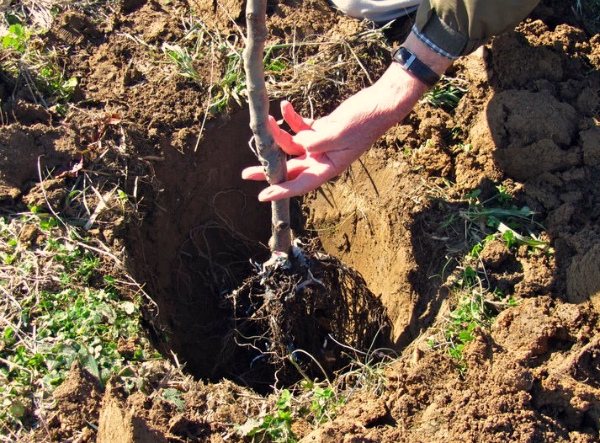

Planting an apple-tree sapling-column.
Advice! Planting and grooming technology practically does not differ from the usual rules and is not burdensome. Therefore, the President is recommended beginners to gain experience.
Timing
Planting is carried out both in the fall after the foliage has fallen, and in the spring before bud break. But preference is still given autumn plantings so that the root system of a tree or seedling can better adapt to soil conditions.
Autumn is a wet period of the year, which has a positive effect on the roots of the seedling. Before the start of the growing season, the root system has time to grow and there is enough get stronger.
If you decide to plant in the spring, then the pit needs to be prepared in the fall.
In any case, the pit is prepared in advance so that the soil can settle and ventilate... There is no big difference in the timing of planting.
The owner decides for himself, depending on climatic conditions and soil indicators.
Features of planting in the fall
The main task for autumn planting is timely pit preparation... It is necessary to prepare and plant a seedling a maximum of two, or even three weeks before the onset of frost. If this is not done, then the roots may not be in time to form in new soil.
The pit should be prepared for month before planting a plant in it.
Pros and cons of planting in the fall:
- A seedling that is planted according to all the rules has time to take root before frost. In winter, it will get stronger so that in the spring, with the arrival of heat, it will begin full-fledged growth;
- Saplings planted in autumn have a higher immune system, are distinguished by their endurance and will not be afraid of spring frosts;
- When the snow melts, a sufficient amount of moisture and nutrients is obtained;
- It is required to cover the roots from possible severe frosts with spruce branches or other suitable mulch.
Autumn comes to each locality in a different way, so gardeners are advised to plant trees immediately after falling leaves.
Distance between seedlings when planting
Columnar culture withstands well thickened planting.
You need to start preparing the seat with the layout.
The scheme is correct layouts for a columnar hybrid, the President should be 60 cm between plants and 100 cm between rows.
Of course, if you plant only 2-3 trees, then the distance in the row spacing does not play a special role.
Correct fit
The size of the pit depends on the composition of the soil:
- If black soil, then its depth and width should be about 60 cm.
- On the poor loamy or clayey the planting pit can be made not so deep, but the width should reach up to one and a half meters, so that the roots with dense soil can freely develop in breadth.
- Sandy ones require deepening by a meter and laying on the bottom of tamped clay for moisture retention.


Tillage and necessary fertilizers.
The hole needs to be filled with fertile soil, compost and add superphosphate and potassium supplements.
Important! Columnar apple trees require a tenfold dose reduction of any kind fertilizers compared to conventional species.
Growing technology and features of care in the first year
This type of fruit tree has an intensive development, therefore, the gardener needs to pay attention to achieve a good harvest.
The hybrid gives a huge amount ovariesthat the plant is unable to cope with.
In the first year, the resulting flowers must be removed.
And in the following years, when flowering, thin out peduncles, gradually increasing the load on the tree every year.
Rationing rules:
- When flowering from the ringlet, without damaging the leaves, remove excess flowers, leaving two at a time;
- The bouquets are thinned out. While there should be 2 times more of them than the alleged apples;
- After the formation of ovaries, they are again halved;
- When the size of the fruit is about the size of a cherry, leave two per bouquet;
- The level of the ranetka suggests that one more ovary needs to be removed, leaving one apple on each link.
Another important point in care is tinning.
Since the stock is clonal, it does not have a taproot that tends to the depths.
The root system is superficial and very fragile... The roots extend from the trunk to a very short distance. Therefore, you need to be careful when tamping the near-stem section and especially when loosening.
In order not to harm the delicate roots, the soil around the stem is tinned with cereal or spicy crops, which are periodically mowed.
Together with tinning they produce mulching periosteal circle.
Agrotechnics
In agrotechnical measures for the cultivation of this crop, special attention is paid to watering and top dressing.
The ideal option is considered drip watering. But in the absence of such, regular watering is required.
If the weather is very hot, then the plant needs a bucket of water, and the already matured tree needs two buckets every couple of days.
A good helper in this case is considered mulch, which is able to retain moisture for a long time and protect the superficial delicate roots from strong heating by the sun's rays.
Like any varietal crop, during the growing season, the apple tree almost completely depletes the soil from trace elements... Therefore, it requires periodic replenishment.
So that the yield is at the level, with the arrival spring the following are introduced into the near-trunk circle:
- Urea - 60 g;
- Mineral nitrogen-phosphorus-potassium fertilizer (nitroammofoska) - 5 g;
- Well rotted humus - 1 bucket;
They can be simply pour and water or dig into the soil.
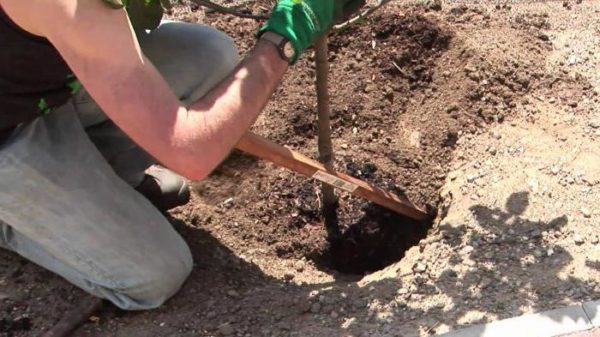

Columnar apple trees planting and care.
Attention! During flowering, feeding with a complex solution of nutrients is necessary. Feed fertilizers are needed every two weeks in small, reduced doses on well-shed soil.
Trimming and shaping
Strong pruning is not required. In the first year more sanitarythan shaping. Lateral shoots are cut into two buds so as not to spoil the appearance of the decorativeness of the plant. Also, these shoots require a lot nutrition, which is necessary for the future harvest.
Advice! If a kidney of the main growth freezes in the cold, then in spring two new shoots will appear in its place, one of which follows delete.
Pollinators
For this hybrid, related pollinators not required.
It is self-pollinated.
But still, experienced gardeners recommend planting other varieties for better pollination.
Ways to combat diseases and pests and their prevention
The undoubted advantage of the President's columnar apple is its resistance to most fungal and bacterial diseases. Unfortunately, this does not apply to such a common problem as scab. And so far not a single breeder is able to protect their own creation from gluttonous pests.
But here, too, columnar apple trees have an advantage over ordinary trees. The consumption of insecticides is significantly less, the plants are much easier to handle. A standard sprayer with a small capacity is sufficient.
Moth
The apple moth is a butterfly that lays eggs in flower ovaries. Caterpillars hatching from these eggs gnaw their way out in future apples and pass into the next fruit. Affected apples stop growing, shrivel and fall off. A small dark brown hole is clearly visible on them, as if covered with a lighter dense mass - the place where the larva emerges from the apple.
The best prevention of the appearance of the moth, like many other pests, is to keep the trunk circle neat. Weed it regularly, in the fall, be sure to rake up all the fallen leaves, fruits and burn. This will deprive the pupae of a good wintering place.
If last year your apple trees underwent a massive invasion of moths, in 2.5-3 weeks after the trees have faded, spray them with Mitak, Kinmiks, Biorin, Inta-Vir. Sumi-Alpha, Fatrin, Alatar, Aivengo are specially designed to combat moths. But they are used at an air temperature not higher than 22-25 ° C. Otherwise, the efficiency drops sharply.
The solution is prepared in strict accordance with the manufacturer's recommendations on the package. The norm for an adult tree is 0.7–1 liters. In the future, two similar procedures will be required - 2 weeks after the first and another 25-30 days. Between the third spraying and apple picking, at least a month should pass, and better - one and a half.
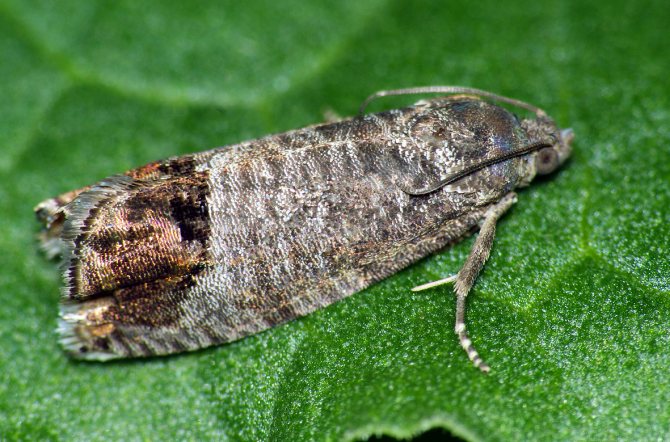

One caterpillar of the codling moth destroys 2-3 apples
Apple blossom beetle
As the name suggests, apple blossoms are mainly affected by the pest. It eats away flower buds from the inside, in those that remain intact, it lays eggs. The hatching larvae eat up the remaining buds, and their waste products glue the petals from the inside, preventing them from blooming. Flower ovaries dry up in the form of a dome, under which the larvae pupate.
The first treatment of a columnar apple tree against flower beetles is carried out at the moment when the leaves are just beginning to bloom. The trees are sprayed with Fufanon, spending about 1 liter of solution for each. Before this, it is useful in the early morning to spread newspapers under the tree and shake it vigorously several times. This will eliminate a significant proportion of adult pests.
A certain number of flower beetles will be delayed by special sticky belts impregnated with Karbofos. But these beetles can fly, so you should not rely too much on such traps.
The second time the apple trees are sprayed while the buds are still tightly compressed and have a beautiful pink color. For this, Inta-CM, Karbofos, Decis, Kinmix preparations are diluted in water.
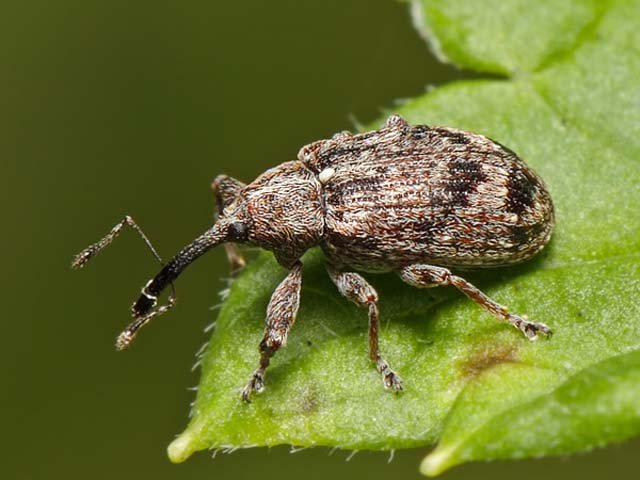

Mechanical methods of struggle are quite effective against the apple blossom beetle, but they need to be used in the early morning, when adults are inactive
Apple honeydew
Also, the pest is known as the lice. The larvae hatch during the appearance of the leaves and suck the juice from them and the buds, leaving sticky products of their vital activity, similar to wax, on them.The glued leaves and buds are deformed, the future yield is sharply reduced.
If the pest is noticed on time, folk remedies help well - an infusion of dry self-grown tobacco, wood ash. A glass of raw materials is poured with a liter of boiling water. The container is closed and left for a day. Filter the product before use. To make it better "stick" to the tree, add a little finely planed laundry soap.
Sometimes infusions of chamomile, garlic shoots, onion husks, yarrow leaves, hot red pepper pods, potato and tomato tops help. Gardeners' reviews about them are diametrically opposite - from enthusiastic to sharply negative. To prepare the infusion, you will need 50–70 g of crushed raw materials and a liter of water. Insist on the remedy for at least a day.
In severe cases, columnar apple trees are sprayed with the preparations Fas, Mitak, Sumi-Alpha, Calypso, Fozalon, Nemabakt.
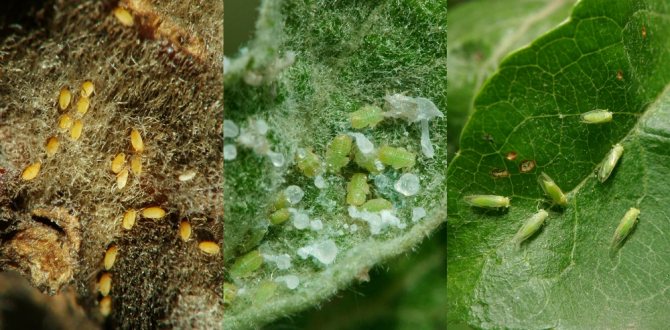

Apple sucker can completely rob you of your harvest.
Aphid
Aphids are a pest that does not disdain the absolute majority of agricultural crops. Columnar apple trees are no exception. Insects settle in whole colonies on the underside of the leaves and suck the juice out of them. From the outside, it looks like multiple small light beige dots - dead areas. Affected leaves turn yellow, dry and fall off.
If aphids have not yet spread en masse, folk remedies help well. The pest does not tolerate pungent odors, so apple trees are sprayed with infusion of garlic, tobacco crumbs, wormwood, marigolds, tomato tops, tansy, dry peels of any citrus. Prepare it as described above.
An absolutely lethal agent is a grated bar of laundry soap, half a glass of wood ash, 50 ml of kerosene and 200 ml of tobacco infusion. All this is thoroughly mixed until the soap chips are completely dissolved and filtered. It is better to first test the product on one of the apple trees to make sure that it does not burn the leaves.
When time is lost, insecticides are used - Kinmiks, Inta-Vir, Nitrofen, Karate. It will take at least two treatments with an interval of 15–20 days. Apple trees are sprayed with insecticides exclusively in dry, calm weather.
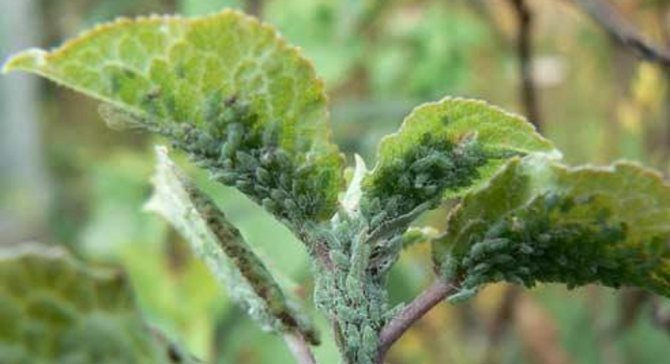

Aphids are one of the most "universal" pests; columnar apple trees also suffer from it.
Scab
Scab is a fungal disease that affects both leaves and fruits. On them appear greenish-brown, velvety to the touch, rapidly growing spots, which soon change color to gray-black. The foliage dries quickly and falls off, the fruits stop developing and also fall off. You can't eat such apples.
If the trees have suffered greatly from scab last year, leaf buds that have just begun to bloom are sprayed with a 2-3% solution of any fungicide - Bordeaux liquid, copper oxychloride (HOM), copper sulfate, Kuprozan, Kaptan. Be sure to carry out preliminary tests. The procedure is repeated when the buds bloom, the third one - after another 12-15 days. In the last two cases, you can replace the fungicide with Skor, Rubigan, Tsineb preparations.
For prophylaxis, annual treatment with drugs that increase the immunity of the plant, starting from mid-May, 3-4 times per season, is useful. Fitosporin, Zircon, Vectra, potassium humate have proven themselves well.
You can combine business with pleasure. Ammonium and potassium nitrate, ammonium sulfate, potassium sulfate are effective against scab. Prepare a solution with a concentration of 10-15% and spray the leaves with it. The tree simultaneously receives foliar feeding and protection from disease.
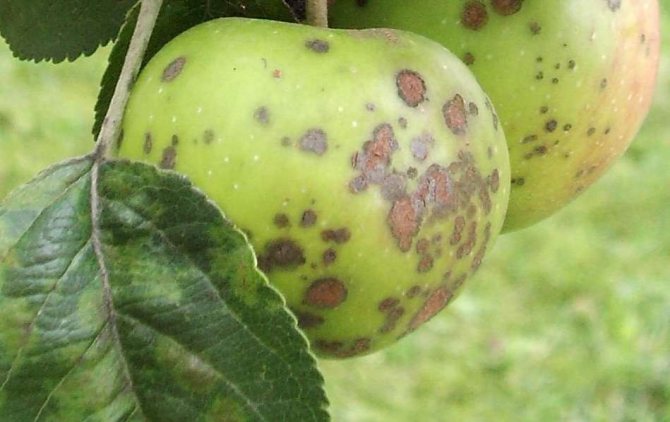

Apple scab is a common problem
Features of ripening and fruiting
The most fruitful are considered from 5 to 8 years of age of the apple tree. Then the yield falls and by the age of 15 it becomes very small.
What year does it bear fruit?
The seedling is capable of blooming in the first year, but color is better to remove... The harvest will be in the second year, which is better to thin out too.
When do the leaves bloom and when do they bloom?
Much depends on the region and the weather... Foliage usually appears in mid-March.
Flowering also occurs depending on the growing region.
In favorable weather conditions it blooms up to 10 days.
Fruit ripening time
Maturity or pouring comes in the middle August and continues until mid-September.
Storage periods
Apples stored in fresh form can be a little over a month.
But with proper storage and observance of the temperature regime from -2 to +5 ° C, storage can last up to New Year.
Testimonials
For many gardeners, the President dwarf apple tree is one of the best varieties that is so popular in modern gardening:
- does not take up much space in the garden, so several seedlings can be planted in a small area at once;
- does not require shaping, in adulthood it tolerates cold well without shelter and has high immunity against fungal sores - thanks to these qualities, care for the fruit crop is minimized;
- large, tasty and attractive harvest is suitable for fresh consumption, as well as preparation of various preparations for the winter.
Features of growing in the regions
- Wide Spread this hybrid was received in Moscow and the Moscow region.
- It can also be found in the Saratov region, in the Non-Black Earth Region and the Black Earth Belt of Russia.
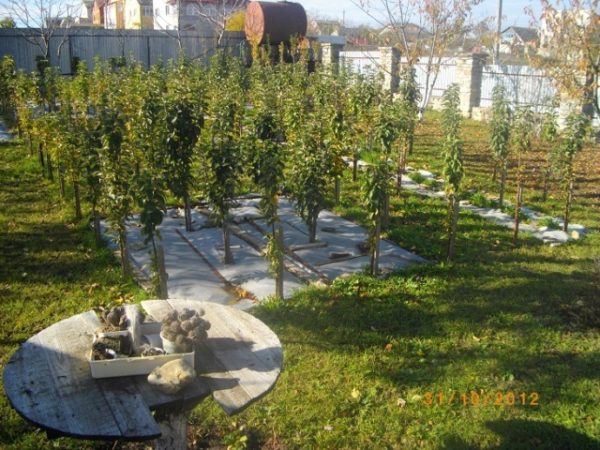

Cultivation of a columnar apple tree.
As for the Urals and Siberia, because of the lack of heat and too harsh winters, the cultivation of this crop is unprofitable. Superficial root system freezes... The tree itself does not withstand frost. Although in the Urals, some lovers grow such an apple tree.
Some gardeners successfully grow the apple variety President in large tubs, which are brought to a warmer place when winter comes.
Advice! Growing a columnar apple orchard requires close attention to it. Like any other plant, care, creation of conditions is required, shaping, pest control, etc.
Breeding history
The history of the President's apple tree breeding began a long time ago. The first hybrids with stable traits were obtained in the middle of the 70s of the twentieth century, thanks to scientists from the All-Russian Institute of Selection and Technology of Horticulture and Nursery (Moscow).
The apple varieties Obilnoe and Vozhak were chosen as the basis for the new plant. The variety was zoned relatively recently, in 2002. The recommended area for growing the plant was the territory of the Perm, Moscow and Samara regions, as well as adjacent climatic zones.

